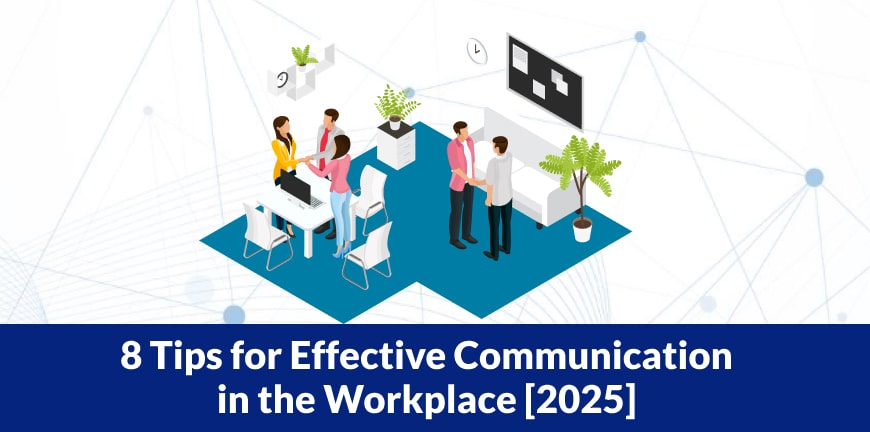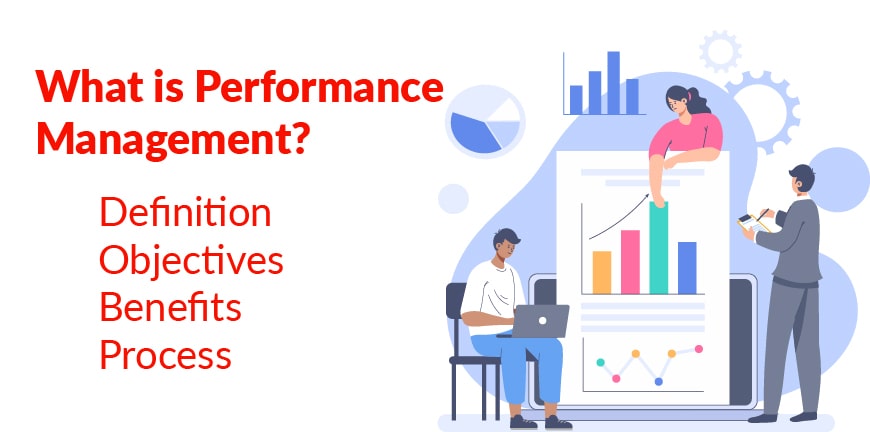
Difference Between Internal and External Recruitment
02/06/2025
5 Best Virtual Onboarding Practices for New Hires
04/06/2025- Introduction
- What is Effective Communication in the Workplace?
- What is the Importance of Effective Communication in the Workplace?
- What are the Benefits of Effective Workplace Communication?
- Top 8 Tips for Effective Communication in the Workplace
- What are the Types and Methods for Effective Communication in the Workplace
- What are the Best Practices & Strategies for Effective Communication?
- What are the Common Communication Challenges?
- Conclusion
- Frequently Asked Questions (FAQs)
Introduction
Is it possible for an organisation to thrive without its employees working in harmony? Definitely not. Co-workers must collaborate, be open to listening to each other’s ideas, thoughts and create a collaborative environment. In 2025, where individuals are so consumed in their own work and lives, communicating at the workplace has become even more important.
However, this is easier said than done. On that note, in this article, we’ll be exploring about the importance of good communication, its benefits, methods and strategies to implement it.
What is Effective Communication in the Workplace?
Effective communication in the workplace refers to co-workers clearly communicating ideas, thoughts, concerns, and knowledge with each other to create an environment that is collaborative and friendly.
To effectively communicate with your co-workers the primarily thing you must be in open-minded. Listen to what they say, try to understand their body language and emotional intelligence to ensure you receive the message right.
What is the Importance of Effective Communication in the Workplace?
Communication is key to solving every problem. Effectively communicating with each other in the workplace not only keeps misunderstanding at bay but also helps employees understand the work that needs to be done, as well as gives rise to a workplace that is friendly and supportive. Communicating in the right manner with co-workers no matter their hierarchy in the organization, helps maintain healthy relationships. Effective communication leads to better productivity, better teamwork and collaboration, higher employee engagement, lesser conflicts, and better decision-making.
What are the Benefits of Effective Workplace Communication?
Some of the advantages of effective communication in the workplace are as follows-
1. Eliminates conflict
By communicating in the right manner, with clear words and clean intentions, employees can reduce conflict. Not putting across your thoughts or concerns properly, leads to misjudgements. Miscommunication can instil feelings of not being heard or understood and even lead to decline in performance.
2. Higher employee engagement
When co-workers communicate in an effective manner, not only do they ensure that the exact message is received but also helps them have open lines of communication. And naturally, when employees feel safe and secure about communicating with each other their engagement also increases.
3. Higher productivity
Employees who feel they are heard and understood at the workplace feel more confident and connected to their work and in turn perform much more efficiently leading to higher productivity. On the other hand, the ones who fail to communicate their needs, often get confused in regard to what exactly their roles and responsibilities are as well leading them to underperform.
4. Better relationships with clients
Not just your employees, but even clients expect an organization to communicate effectively with them. By hearing them out and understanding their expectations clearly and communicating with them about how you can help them in what timelines keeps confusions at bay and helps build trustworthy relationships.
5. Helps maintain relationships
By communicating with empathy, kindness while putting across your thoughts helps maintain healthy relationships. Your company may have employees coming from diverse cultures, backgrounds, and ethnic groups. By fostering a culture of open communication with each and every one can make all employees feel safe and heard.
6. Better direction for employees
When managers communicate clearly with their team, about what the company is looking for and how their role can have an impact, individuals will have a better understanding of what and how to perform their duties in their respective roles.
7. Higher employee satisfaction
Effective communication skills can help employees feel more satisfied about their jobs because they are comfortable talking to others at the workplace about everything without feeling uncomfortable about it. And when more and more employees do this, a harmonious workplace is created.
8. Better public impression
Companies that are known to have a good reputation with its employees as well as clients do one thing right and that is communicating with them properly. This aspect helps build company reputation leading to better business.
Top 8 Tips for Effective Communication in the Workplace
To ensure effective communication in the workplace, you must put in some effort. Here are a few pointers to help you do the same-
1. Listen actively to others
To listen actively, one must attentively listen to what the other one is saying or trying to communicate. Further you must process that information, formulate a response, and retain the information. Employers must motivate their employees to hear the speaker out, ask questions to clarify, and affirm the speaker’s point of view.
2. Have clear communication channels
Having the right channels of communication and making sure every employee can not only access it but can communicate with anyone in the organisation easily is especially important. These channels could be email, meetings, messaging platforms and more.
3. Encourage open communication
Make your environment communication friendly. By this we mean, make employees feel like they have the right to speak their mind, even if that means disagreeing with others. Only then will there be a healthy environment.
4. Use technology
Digital technology can help a great deal in communication. Whether it’s someone working in a remote setting or individuals who aren’t comfortable to go and talk in-person, having digital means to communicate can help a great deal.
5. Provide regular feedback
If there are concerns or even positive feedback, make sure you communicate the same to employees on a regular basis to ensure growth in their career and the growth of the organization is not affected.
6. Transparency
Whatever may be the goals or objectives of your organization, every employee must be made aware of it regardless of how greatly or not they can contribute to it. Making them part of the bigger picture makes them feel important and instils loyalty.
7. Communication training programs
You can organize certain programs to help your employees learn about the art of communicating effectively. Training your employees to listen actively and make them aware about conflict resolution in the right manner is crucial.
8. Recognize and reward achievements
When an employee is dedicated or does something that deserves praise or recognition. Do it. When you let your employees know that you are proud of their achievement and value their hard work the satisfaction levels are elevated.
What are the Types and Methods for Effective Communication in the Workplace
There are several types and methods of effective communication in the workplace. They are categorized into –
- Verbal
- Nonverbal
- Written
- Visual
The way you are communicating depends on who you are communicating with and the purpose of it. There is different communication methods suited to different situations.
1. Verbal communication
Verbal communication is the spoken word used to communicate with others. This can be done either in-person or through digital means like over telephone, video call, skype etc. Talking in-person is ideal, but in today’s time with employee working in different regions this isn’t ideal. Verbal communication can be formal, as in for meetings or interviews or informal when communicating casually with a co-worker.
2. Non-verbal communication
Non-verbal communication helps you understand how the other person is feeling or thinking without the use of words. This type of communication includes judging by facial expressions, hand movements, eye contact, posture, touch, and tone of voice. Suppose someone is crossing arms, either they are reluctant to speak or angry or are disagreeing with you. Knowing what they are trying to communicate through their body language is important.
3. Written Communication
This type of communication could either be through a letter, email, or messaging through social media. Written communication should aim to get your message across in a clear and concise manner.
How effectively you communicate through written word will depend on grammar, vocabulary, or clarity. Written communication through emails works well especially when you want to reach a person who may or may not be available immediately, but you need to send across the message to them.
4. Listening
Active listening is the most important type of communication as its one of the most effective ways of communicating with others in the workplace. When you actively listen, you can respond just as well. When it comes to settings like meetings or seminars, if individuals cannot pay attention and listen the entire time then they record the sessions.
5. Visual Communication
As the name suggests this includes various visual aids like drawing, graphic design, signs, typography, illustrations, and colour. By using graphs and charts you can communicate your message. Visual communication is all around us whether that be on the television, social media, or advertising campaigns. Advertisers use it to sell products or give us a certain message.
What are the Best Practices & Strategies for Effective Communication?
Building your communication skills takes practice. To hone this skill, you must find your weaknesses and consider focusing on one or two strategies at a time. To improve communication skills, notice your current communication style and focus on areas for improvement and try to convey better ideas, thoughts, actions, and opinions in your personal and professional life. Consider the following strategies to get started.
1. Convey important points in a clear manner
Your message must be easy to understand. Use actions verbs where possible, say it in clear terms instead of vague ones, don’t use complicated words, end with a call to action if you want your listener to deliver something. In written communication try to use bullet points to convey your message.
2. Use distinct modes of communication
You may use a visual and written method of communication; you can have face-to-face conversations or even use non-verbal communication like use body language to communicate what you want to. Using the right mode of communication can add clarity to what you are trying to convey.
3. Watch your tone
What you say definitely matters, but in many circumstances how you say it matters even more. You must be mindful of how you are speaking. Also, using a tone that is subtle yet makes sure you send across the message properly is important.
4. Maintain the right body language
Your body language can reveal a lot about what you are trying to convey. While it may be challenging to a certain level to control or understand non-verbal cues it could help in certain situations.
5. Know your audience
Know who you are talking to. If it’s a co-worker who is working in the same field and the same level as you are then you can relax your body tone and speak casually. If you are talking to someone who is above your level and in managerial position you must be more formal in your tone and body language.
6. Ask for feedback
If you have already communicated your piece, especially to your boss, then watch for non-verbal cues as to how they react to what you said or if its ok then ask your boss to offer you with feedback as to what you could have done better to communicate better.
What are the Common Communication Challenges?
- Your accent or dialect can create misunderstanding sometimes. Also, not using specific terms can confuse people.
- Misreading verbal and non-verbal communication styles is common
- When you don’t listen the other person properly, it can lead to missing out on information
- Not using precise language can get confusing to the listener.
- If you are having strong emotions while saying your piece, it may cloud judgement leading to ineffective communication.
- Don’t overload the person with too much information and especially unnecessary information
- Use the right channels for communication
Conclusion
No matter which metrics you focus on (engagement, productivity, etc.), the success of your company depends on communication. Workplace communication isn’t rocket science, but you must not ignore it. If you want to improve your communication at your company and want others to take your communication willingly, you’ll want to invest in a system that supports your goals.
Frequently Asked Questions (FAQs)
1. What is effective communication in the workplace?
Effective communication refers to speaking to your co-workers in a manner that not only sends your message across properly but also being able to receive the message the other person is trying to convey in a precise manner.
2. Why is effective communication important at work?
Communicating properly is the only way to get your doubts cleared, move past issues or even come up with innovative ideas to progress in your role as well in the workplace.
3. How can I improve my communication skills at work?
You can improve your communication skills at work by being mindful of certain aspects like watching your tone, using the right method of communication, use right body language, actively listen, and receive feedback.
4. How can technology improve workplace communication?
Modern technologies allow teams to collaborate and share information without having to be in the same room, paving the way for the remote office.
5. How do you handle difficult conversations at work?
If you want to convey something that is sensitive in nature, at your workplace, then you must be kind, empathetic and say it in a way that doesn’t make you look bad or doesn’t bring out your emotions in the wrong manner.
Contact Us For Business Enquiry

Rajkumar Shanmugam
Rajkumar Shanmugam is the Head of HR at ALP Consulting, bringing over 19 years of comprehensive HR leadership experience across India and international markets. His expertise spans talent acquisition, employee relations, performance management, compliance, and HR transformation. Rajkumar has a proven track record of driving people-centric initiatives, enhancing workplace culture, and aligning HR strategy with business goals. With extensive experience in US staffing operations and global mobility, he continues to lead organizational excellence through innovation and employee engagement.




